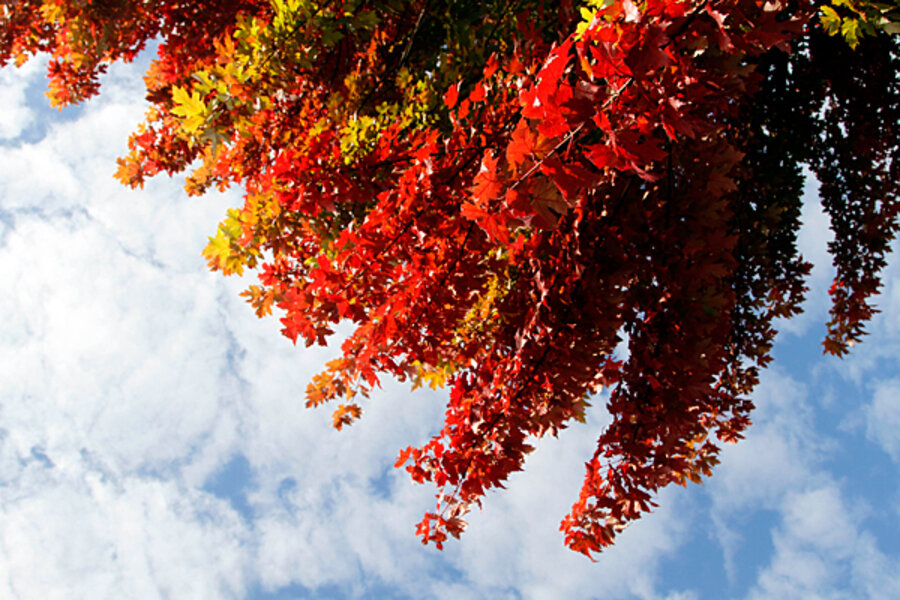Autumn begins: Will weather pattern leave leaf-peepers blue?
Loading...
| Boston
Autumn has arrived, and with it visions of leaf-peeper caravans snaking their way by brilliantly colored, sun-lit trees along tranquil rural roads, of crisp nights spent at cozy country inns and B&Bs.
That is certainly the image promoted by state departments of tourism, inn keepers’ associations, and countless travel websites, which eagerly anticipate every fall’s rush of business.
But fall foliage seasons, and the leaf chemistry that creates them, are notoriously vulnerable to weather conditions, and this year may be a case in point after a summer of extreme heat and dryness in the Northeastern US, where some of the more vibrant displays of color can usually be found.
“This year we had an exceptionally dry and warm August and early September,” said Richard Primack, a professor of biology at Boston University in Massachusetts, “so this caused a lot of birch trees and other trees to lose their leaves prematurely.”
The best autumn foliage follows growing seasons with ample water followed by cool and dry weather in early fall. With dropping temperatures and less daylight, the leaves lose the chlorophyll that makes them green, leaving underlying pigments of red, yellow, and orange.
The diversity of tree species in New England make it the region best known for peak foliage, explains Andrew Richardson, an assistant professor of biology at Harvard University in Cambridge, Mass.
“The reason the colors are so strong in New England is that many native species [red and sugar maple, red oak, dogwood, cherry, and ash] produce anthocyanins,” he said. Anthocyanins are pigments found in plants that are believed to protect plant tissues from some wavelengths of light, such as ultraviolet. “Species which do not produce anthocyanins – birch, beech, and poplar, for example – don't have such colorful foliage.”
New England industry
In the northern New England states of Maine, New Hampshire, and Vermont, foliage season occupies an important place on the tourism industry calendar. On the website of Vermont’s Department of Tourism and Marketing, a map shows that Vermont’s foliage will peak throughout mid-October.
A broader nationwide foliage forecast can be found on The Weather Channel, which features regional maps that outline when and where fall foliage will peak. Across the US, state tourism offices release reports and maps of fall forecasts provided by state officials, foresters, park rangers, or volunteers, many of whom are owners of hotels or inns.
Volunteers or "foliage spotters" are the main source of information for The Foliage Network.
Jerry Roth, a volunteer leaf spotter and owner of the Ivy Bed and Breakfast in Warrenton, N.C., says that fall coloring hasn’t hit quite yet in North Carolina, where he says the leaves never get as red as the northern states. Mr. Roth believes that the dry weather will make leaves fall faster this season.
Jannette and Pat Quackenbush, owners of the Hocking Hills Maple Farm in Creola, Ohio, also participate as spotters for the Foliage Network. They follow fall weather because of its impact on planting, and pass their reports on foliage to the Ohio Department of Natural Resources. Mr. Quackenbush says fall colors have already started in Ohio with lighter yellows and oranges. He believes the season will peak between October 15 to 20.
Early autumn
Back in New England, Don McCasland, program director at Blue Hill Meteorological Observatory in Milton, Mass., said in an interview with The Patriot Ledger newspaper that the first signs of color are already visible in some areas, about 10 days earlier than normal.
“Because trees are not quite as healthy, the chlorophyll is going away faster so some trees are turning yellow quicker,” Mr. McCasland told the Ledger, adding that the red hues associated with some species of maple trees could be harder to find this fall.
He estimated that the foliage would peak in northern New England in early October, as long as a major storm doesn’t end things sooner.
Ted Howard, professor of forestry at the University of New Hampshire in Durham, emphasized too that the dryness of the just-ended summer could result in less vivid colors, and in weakened leaves that will be knocked down faster by pelting autumn rains.
He also anticipated the dreary inevitable flip side of every fall’s foliage spectacle: “In early November most colors will be gone,’’ he said. “There will be a few leaves here and there, and then it will be time to rake.”





